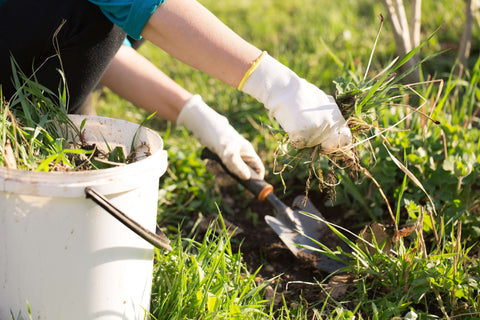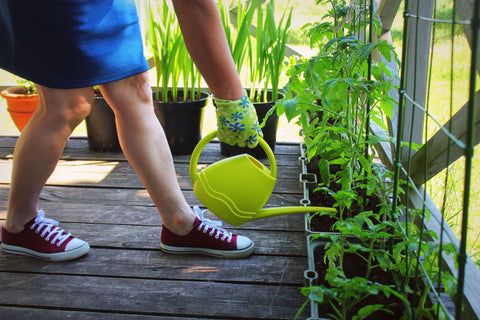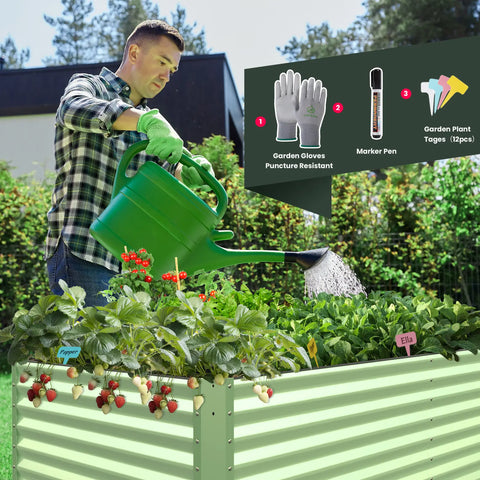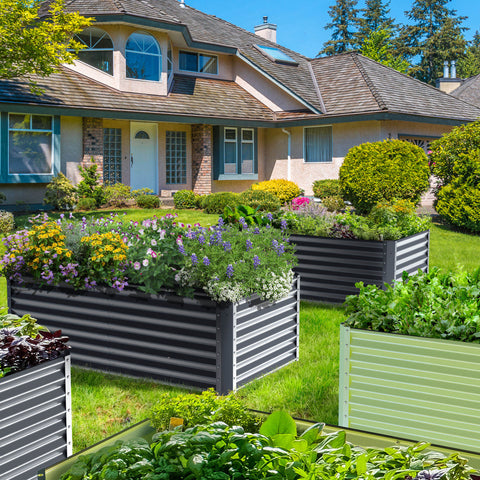Looking for natural ways to prevent pests in your garden this season? There are many natural ways to control pests in gardens without using harmful chemicals. In this article, we will share the best techniques for naturally handling common garden pests during this season without using irritating chemicals.
If you are a gardener, you will almost certainly encounter problems with pests. The range of pests is wide, from minor disturbances to major disasters in family gardens. The more you know about common garden pests, the better you can plan your garden to prevent, avoid, or deceive them and minimize damage.

Garden pests can be small or large, and can appear at any time during the growing season. Once you see one, you may already have more than one! Some of the most common small pests include slugs, Japanese beetles, flea beetles, aphids, and caterpillars. The larger dislikes include deer, rabbits, squirrels, raccoons, mice, and birds.
Pests eat leaves, suck plant sap, and burrow into fruits, vines, and tree roots. Mammals and birds will eat your products, chew on leaves, or dig out tender seedlings. Watching a tomato waiting for its first ripening in a year, only to be bitten by a hungry animal before it ripens, is very frustrating. Similarly, if you have been observing the growth of your plants and one day notice that the leaves are full of holes, you know it's time to take action!
In many cases, prevention is better than treatment. There are some quite simple ways to prevent pests from damaging your garden. In this article, we will take a closer look at 15 tips that you can use to prevent and treat garden pests!
1.Don't invite mammals into your garden
Installing fences is the simplest way to prevent most mammals from entering the garden. You may not be able to fence all mammals out of the garden, but you can prevent them from approaching your plants.
The fence needs to be very high to keep the deer out, usually at least 6 to 8 feet high. In order to raise rabbits, there should be a small hole or no hole 2 feet below your fence. Squirrels are particularly difficult to stop as they can easily climb over or pass through most fences.
Another way to stop mammals is to remove any attractive mammal habitats from your garden area. Do not feed birds at the edge of the garden, as bird seeds can also attract mammals.
Composting is also attractive to many mammals, so separate your compost pile from your garden or place it in a mammal resistant container. Also, do not let shrubs and wooden stakes come close to your garden, as they can provide shelter for many small mammals.

2.Control weeds
Weeds are not only unsightly, but also cause many gardening problems. When your plants compete with thriving weeds, they are directly competing for light, water, and nutrition. Weeds can also protect and shelter pests. Insects can easily hide in dense weeds, forage, reproduce, and evade potential predators.
Regularly check your garden plants. Weeds grow quickly, so as soon as you see them sprouting, pull them out. The earlier you uproot weeds, the less chance they have of growing and reproducing.
Allowing weeds to bloom and bear seeds will only result in more weeds, more trouble, and possibly more pests. Keeping the garden weed free will help reduce unnecessary pest friendly habitats.
3.Clear
Keeping the garden clean helps naturally prevent pests. Removing leaf debris, dead leaves, and decaying plant materials can help control pests. Insects hide in fragments of leaves.
In winter, any dead plant in the garden can become a refuge for overwintering insects, their larvae, and eggs. If you were infested by insects or diseases last year, do not leave any infected or diseased plants in the garden and reproduce again this year.
Stacking a pile of garbage in your garden may be tempting, but it's best to maintain a certain distance between garden garbage and healthy plants. Rotten plants are magnets for pests and diseases, so it's best to pile up garden waste in a completely separate place.
When you inspect your plants, remove all leaves, stems, or whole plants that are dead, diseased, or infested. Don't wait for small problems to become big problems. Be proactive and clean up the situation.
4.Make some dilutions
Plants that are too crowded can easily breed diseases. Plants benefit from good air circulation. Good air circulation helps prevent common fungal diseases such as powdery mildew and black spot. Allowing sufficient air circulation and spatial growth also helps plants maintain health. Healthy plants are stronger than unhealthy ones and have stronger resistance to pests and diseases.
Another reason to trim plants and avoid overcrowding is to help protect them from pests. If you have a dense and delicious plant, any pest that discovers it can quickly transfer from one plant to another, eat enough, and lay eggs along the way.
If plants are densely distributed, pests can also more easily find delicious plants. Pests such as slugs, thrips, aphids, and caterpillars can thrive in dense, crowded, moist foliage jungles, protected from predators.

5.Use soil well
A good and healthy garden soil is not just 'soil'. Soil is a vibrant ecosystem that is well worth investing in to create. Provide high-quality, nutrient rich soil for your plants.
The best way to add natural superpowers to your soil is to add some organic compost. Work in compost and then cover the soil surface with a layer of mulch to maintain moisture and reduce weed seed germination.
Maintaining good balance and healthy garden soil is one of the best things you can do to improve plant health. Healthy plants are robust and have stronger resistance to pests.
In addition to using compost regularly, you can also try to plant cover crop, add nutritious plants to your garden, and then cultivate them to improve the soil quality. Cover crop usually include clover or other kinds of legumes, which can help supplement nutrients back into the soil and reduce nutrient consumption.
6.Apply cover
Root protectors are both decorative and very useful. Any covering can help maintain soil moisture. Organic and biodegradable mulch, such as wheat straw, can help nourish the soil after decomposition. Mulching can also prevent some common garden pests.
Plastic film can provide a useful protective layer between vegetables and exposed soil, which is where many pests hide. Slugs, beetles, and earthworms all live in or on the soil, while vine moths burrow into exposed stems.
Adding a layer of straw cover to the roots of plants can help protect exposed stems from these annoying vine borers. The covering layer can also prevent fruits from coming into contact with the ground, avoiding attracting other pests and diseases through direct contact with the soil.
7.Watering plants appropriately
Plants can be thirsty at any time, but watering in the morning does have some benefits, especially for plant health. The first thing plants do in the morning is to efficiently utilize water.
Before the weather becomes hot and sunny, they absorb the necessary water, start the day with a fresh mood, and prepare for important photosynthesis. Another benefit of watering in the morning is that water has a greater chance of being absorbed by the soil and plant roots, rather than evaporating in the midday sunlight.
When watering, try to water the garden plants from the bottom instead of spraying them on the leaves. The use of soaking hoses or drip irrigation systems is a great way to obtain water where it is most needed: the roots. Some people sprinkle water on the leaves without letting it seep into the soil. Plants benefit from water that penetrates deep into the soil several times a week, which is much better than occasional light rain.
Now you may want to know how proper watering can help plants avoid pests? Like other aspects of plant care, healthy plants are resistant plants, while well watered plants are healthy plants. Weak plants with water trapped on their leaves may attract pests and diseases
You can also use water to eliminate pests. I know I just said try not to let the leaves get wet, but sometimes this can be a good thing!
If there are a bunch of insects on your plant leaves, sometimes a strong stream of water is enough to knock them down and disperse them. Although this may not truly eliminate pests from your garden, it can sometimes confuse them and give plants a clear advantage without using any harmful chemicals.
8.Enjoy the benefits of peer planting
Companion planting is a common horticultural practice where different types of plants benefit from each other when planted adjacent to each other. Appropriate companion plants can help provide structure or support, provide shade, help fertilize soil, or typically provide improved growth conditions. Accompanying plants can also help attract beneficial insects and drive away pests.
Companion planting can be seen as a method of confusing pests. Single cultivation attracts pests. A large area of land planted with a single variety of crops will definitely attract a large number of pests who like to eat this crop. In smaller areas where several plants are planted, pests may find it difficult to gather, as their preferred plants are scattered between uninteresting and potentially objectionable plants.
There are many flowers and herbs famous for repelling insects. Many plants with strong natural odors are beneficial for resisting pests and hungry herbivores. As for flowers, you can try planting borage, marigold, lotus, or pansy.
Try planting basil, scallions, garlic, mint, or sage as herbal companions. To maximize the benefits of accompanying plants, plant several accompanying plants near the garden plants you want to protect.
9.Implement rotation
For several reasons, rotation is a good idea. It can help balance soil nutrients, and it can actually improve soil quality. Crop rotation is another effective method to confuse pests. If you plant the same crop in the same place year after year, pests and pathogens will gather in the soil, leaf debris, and general areas. You provided a stable and predictable food supply for that pest.
Planting the same crop or family members in the same location requires waiting for 2 or even 3 years. In the middle years, plant a completely different family of cover crop or other crops that may help to fertilize the soil, such as beans or peas.
This gives the soil time to recover, which can actually improve soil fertility. It can also prevent the accumulation of specific pests in the same area for many consecutive years.
Implementing rotation on a small piece of garden land is very challenging. For example, if you only have a raised seedbed and you want to plant tomatoes every year, you can at least plant tomatoes in different corners of the seedbed every year.
If you have 3 or 4 small raised beds, you can transfer crops to your family in a clockwise direction every year, for example, with a slight health change.
10.Attracting beneficial insects
Not all insects are pests. Many insects are beneficial to the garden environment. Pollinators help plants grow and reproduce. Predatory insects eat other insects that are harmful to horticultural crops. If your garden has what they want, mainly flowers and other insects, then beneficial insects will naturally be attracted to your garden.
Ladybugs are greedy predators that feed on aphids, mites, and other common pests. Grassflies also eat a large amount of aphids. Mantis will eat almost any insect they can catch, including many annoying pests.
Parasitic wasps are highly diverse and find hosts among equally diverse garden pests. These beneficial insects are not harmful to humans, but they are very valuable in controlling the number of pests.
Understand what these beneficial insects look like, so you can welcome them to your garden. Many beneficial insects are attracted to flowers, such as coriander, dogwood, dill, chrysanthemum, parsley, pansy, and yarrow. Once you have beneficial insects and know their appearance, treat them as good garden friends to protect, and of course, do not spray pesticides on them.

11.Inviting Birds
Blue birds eat a large amount of insects every day, just like bluebirds, warblers, sparrows, wrens, and anti tongued birds. If you put a blue robin box in winter, by spring, you may already have a blue robin nesting.
But building a blue bird box is just one way to attract birds to your yard. If you put in a bird feeder or bird bath, you can start creating a warm environment for various birds.
If you want to attract birds, create a bird friendly yard. Planting shrubs provides opportunities for habitat and nesting. Plant plants that can produce fruits, berries, and seeds to attract birds. Use a variety of plants, including vines, evergreen trees, and of course, a large number of local species to provide your insect eating feather friends with the widest range of habitats and food sources.
12.Using floating row covers
If you have never tried floating row coverage, this can be a very convenient and effective method to prevent pests. Floating cover is a very lightweight fabric material that is placed on plants in parts or throughout the growing season. Floating row covers can be used in early spring and late autumn to extend the growing season, but they also provide a physical barrier to prevent pests.
Floating row covers may be most effective for various green leafy vegetables as they do not require pollination. They can prevent the caterpillars of cabbage worms and cabbage ring worms from invading cruciferous vegetables.
A flowing hood can prevent flea beetles on vegetables, potatoes, and eggplants. They can also prevent early cucumber and pumpkin pests, but the canopy must be removed during flowering so that these plants can pollinate.
13.Do not compost infected plants
Whenever you have serious insect infestation or seriously diseased plants, the best way is to destroy the diseased plant materials. Most people do not get enough hot compost piles to truly disinfect their compost, and any remaining pests or diseases can be transferred back in the future!
Don't put pests and diseases in compost, leave them in the garden, or try putting them in the soil; You will only keep pets and pathogens for longer. Healthy compost is made from healthy plant materials (free from pests or insect eggs, diseased materials, and weed seeds).
If you have tried to eliminate pests, but the problem is getting worse, then it is time to remove them from your garden. You can remove severely infected stems, leaves, or entire plants and dispose of them in plastic bags.
After handling infected plant materials, it is important to wash your hands and tools thoroughly, so that you do not accidentally transmit insects or their eggs to other healthy plants.

14.Learn to recognize correctly
Do you want to know the difference between a good bug and a bad bug? Learn to identify the adults and larvae of common pests and beneficial insects. Adult ladybugs are very familiar and easy to recognize.
But can you determine the larval stage of ladybugs in your area? Ladybug adults and ladybug larvae are both hungry predators, feeding on aphids and other pests, and they should be welcomed in gardens. As a novice gardener, I cleaned up many ladybug larvae, thinking they were pests, and then realized that they were actually very beneficial!
Learn to identify the different life stages of ladybugs, lacewings, mantis, and parasitic wasps. Learn to identify some of the most common pest species, such as Japanese beetles, aphids, thrips, cucumber beetles, and flea beetles.
Furthermore, be fully aware that if you plant herbaceous plants such as parsley, dill, and fennel, the caterpillars that feed on these plants come from the beautiful swallowtail butterfly. If you want to attract butterflies, you must feed their caterpillars. Looking forward to losing some plants, but gaining some beautiful winged insects!
15.Try diatomaceous earth
If you are struggling with pests and urgently want to kill them, buy a bag of diatomaceous earth. Diatomaceous earth is a white powdery substance that is non-toxic to humans and plants, but harmful to soft insects. Diatomaceous earth is a completely natural product. It is the fossil remains of tiny diatoms and can serve as an effective insect deterrent for organic gardeners.
You can sprinkle diatomaceous soil on the soil around the plants, or directly on the leaves and stems. Just remember, although it won't harm most winged beneficial insects or earthworms, it's not as effective when it's damp; Water saturates small diatom shell particles and softens them.
There are many ways to create a healthy garden environment without using any toxic chemicals. Physical barriers can be a good choice to prevent pests, but this is not always a practical choice. Creating healthy soil, providing ideal growth conditions, and planting various plants can greatly help prevent insect outbreaks.
You can also strive to attract beneficial insects and carnivorous birds. Anything you can do to encourage strong and resilient plants will be beneficial and help create a vibrant and vibrant garden.









